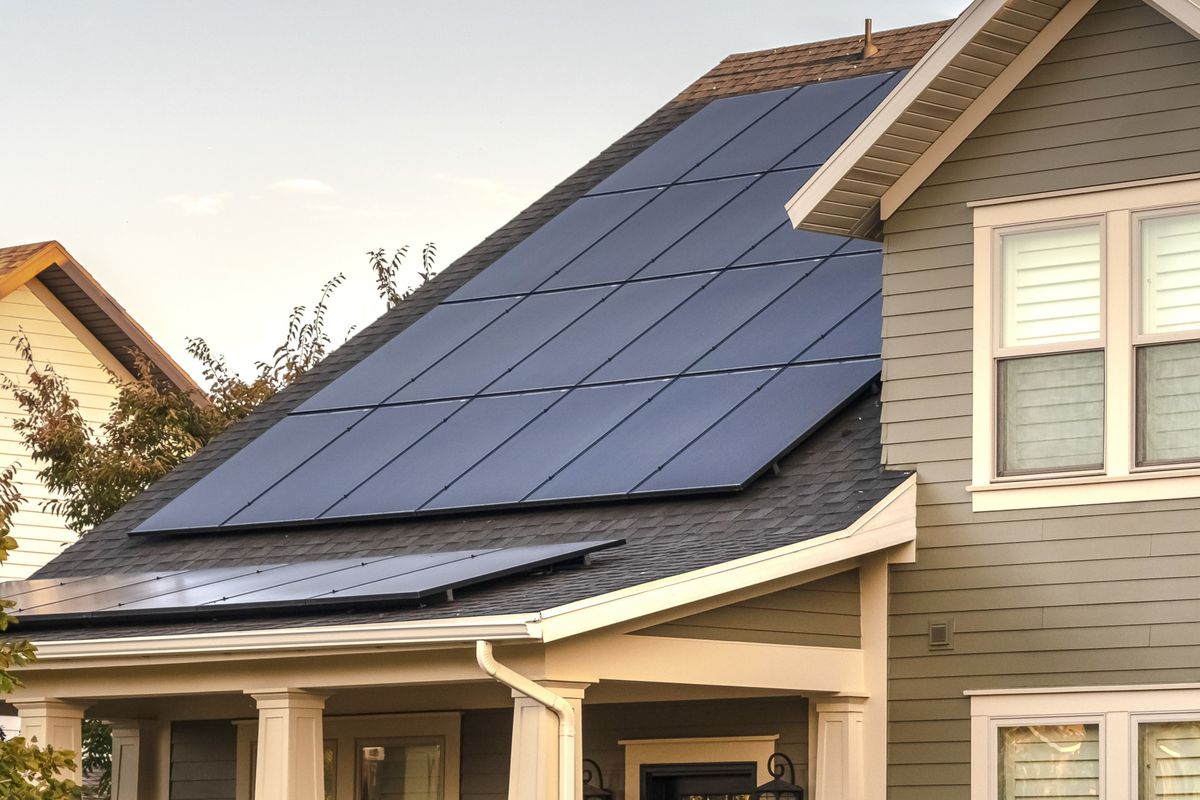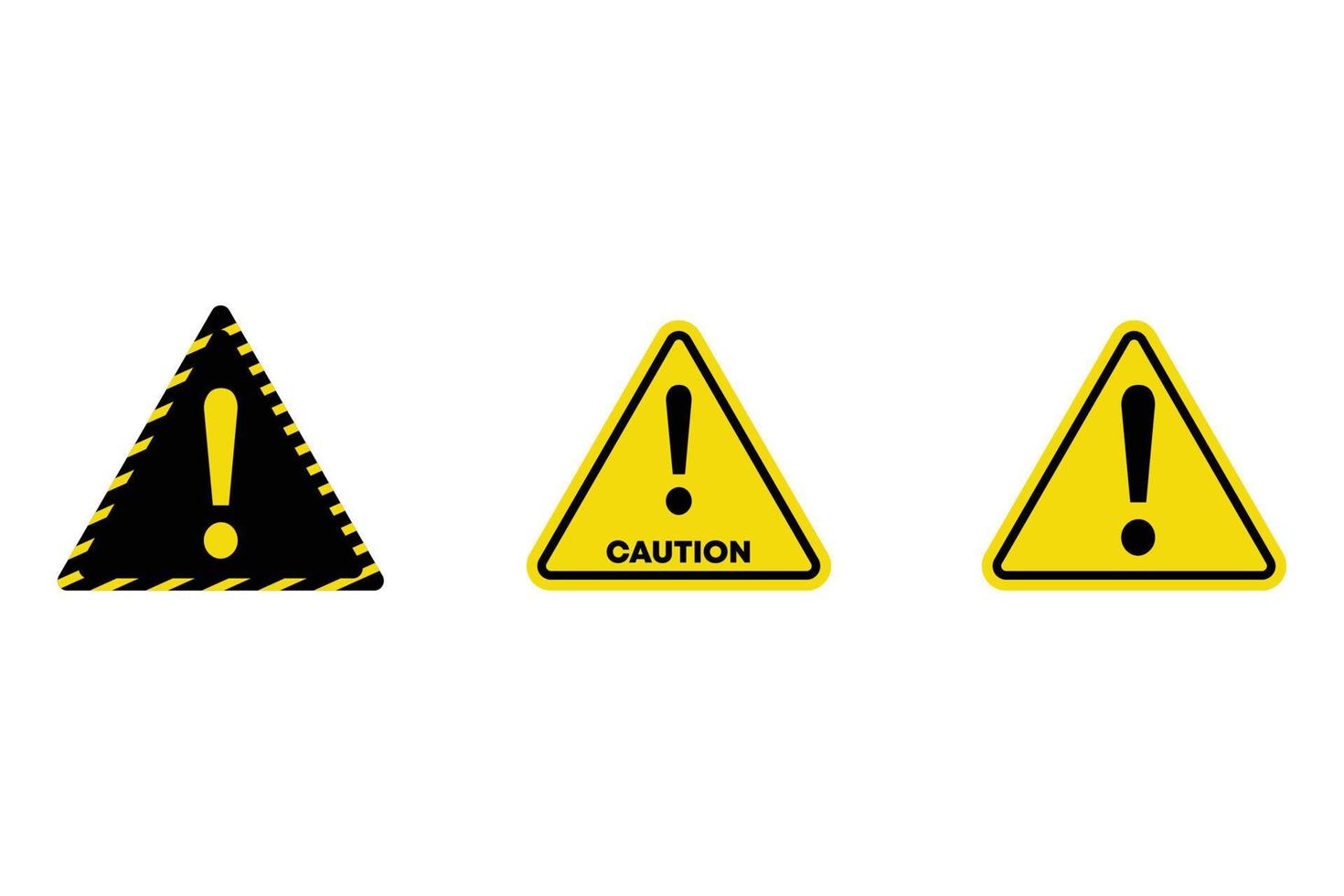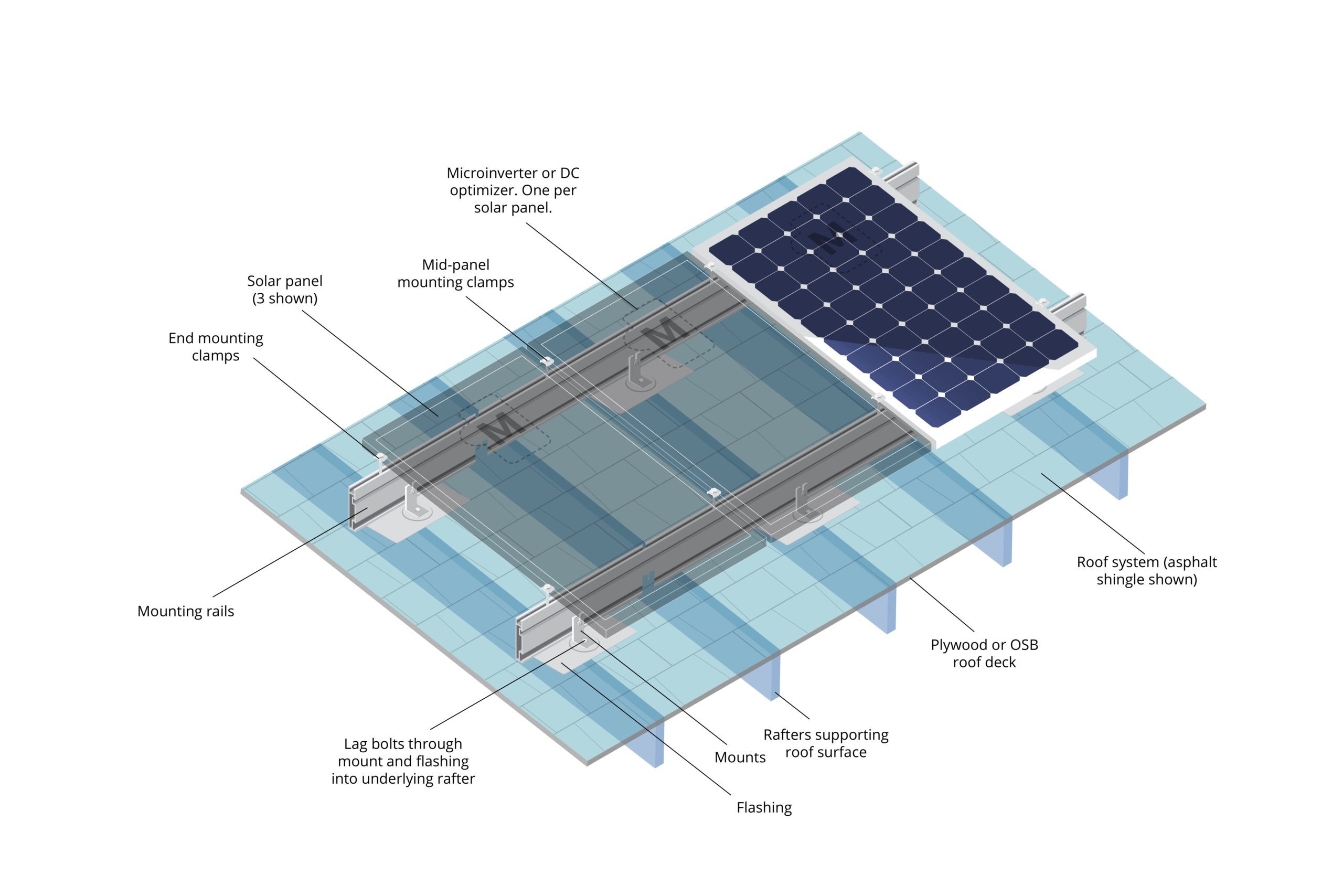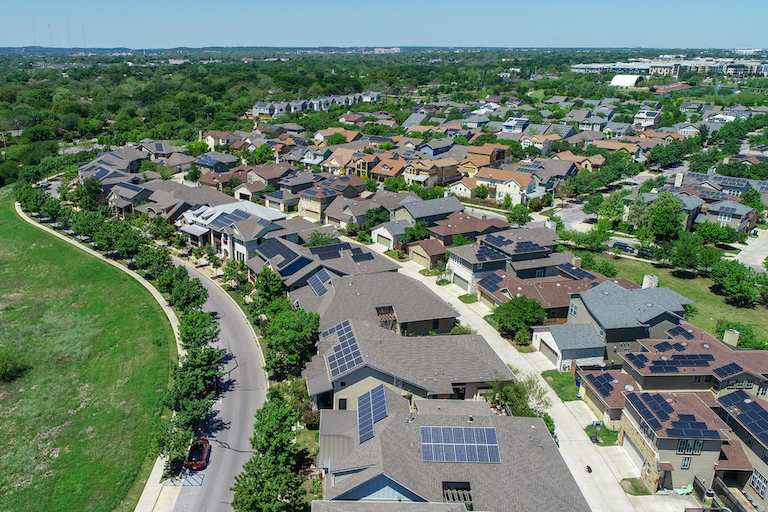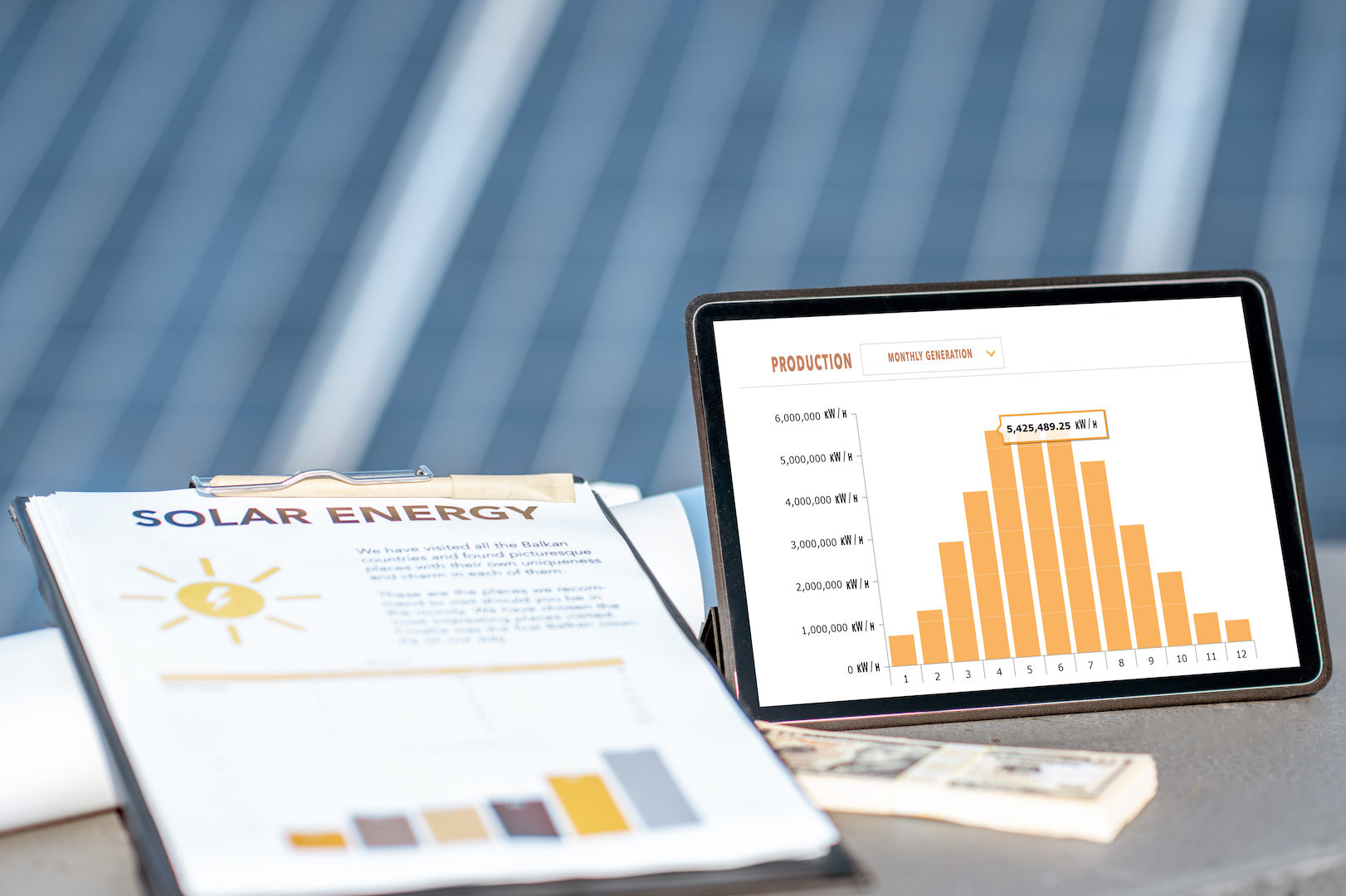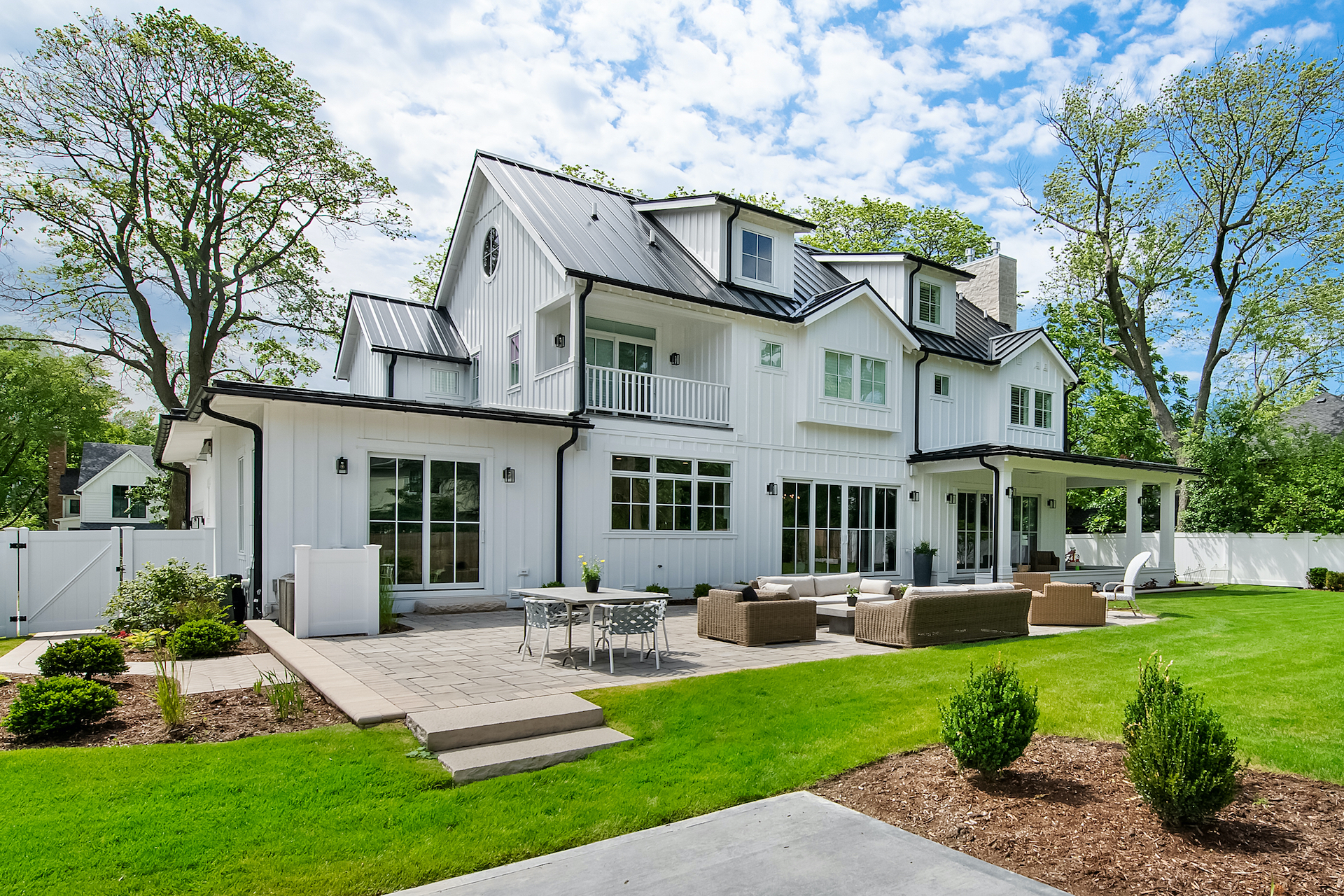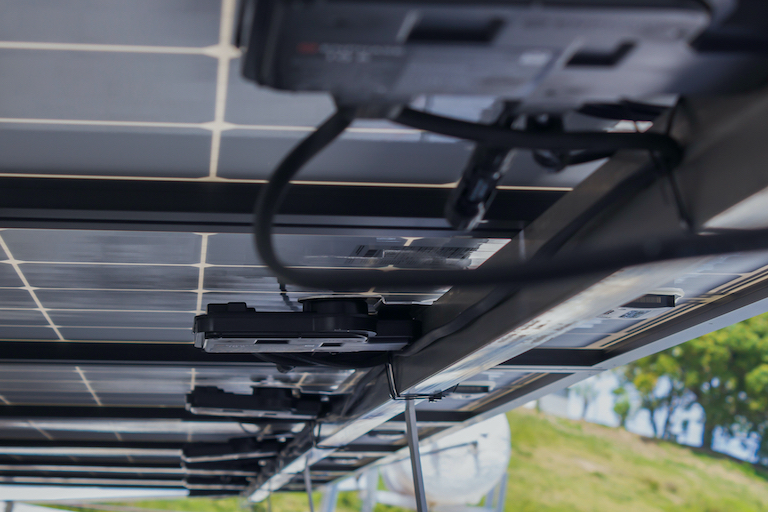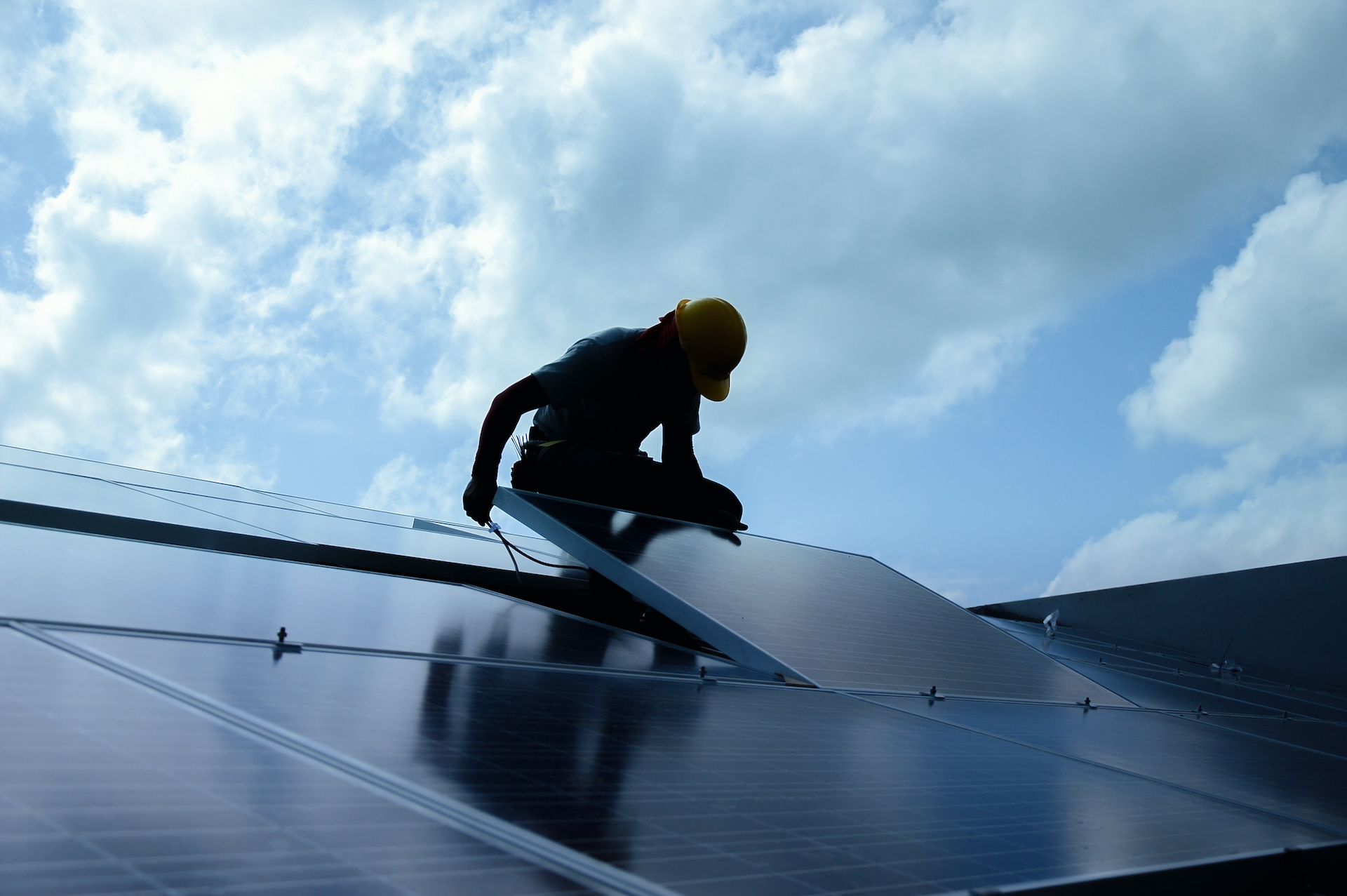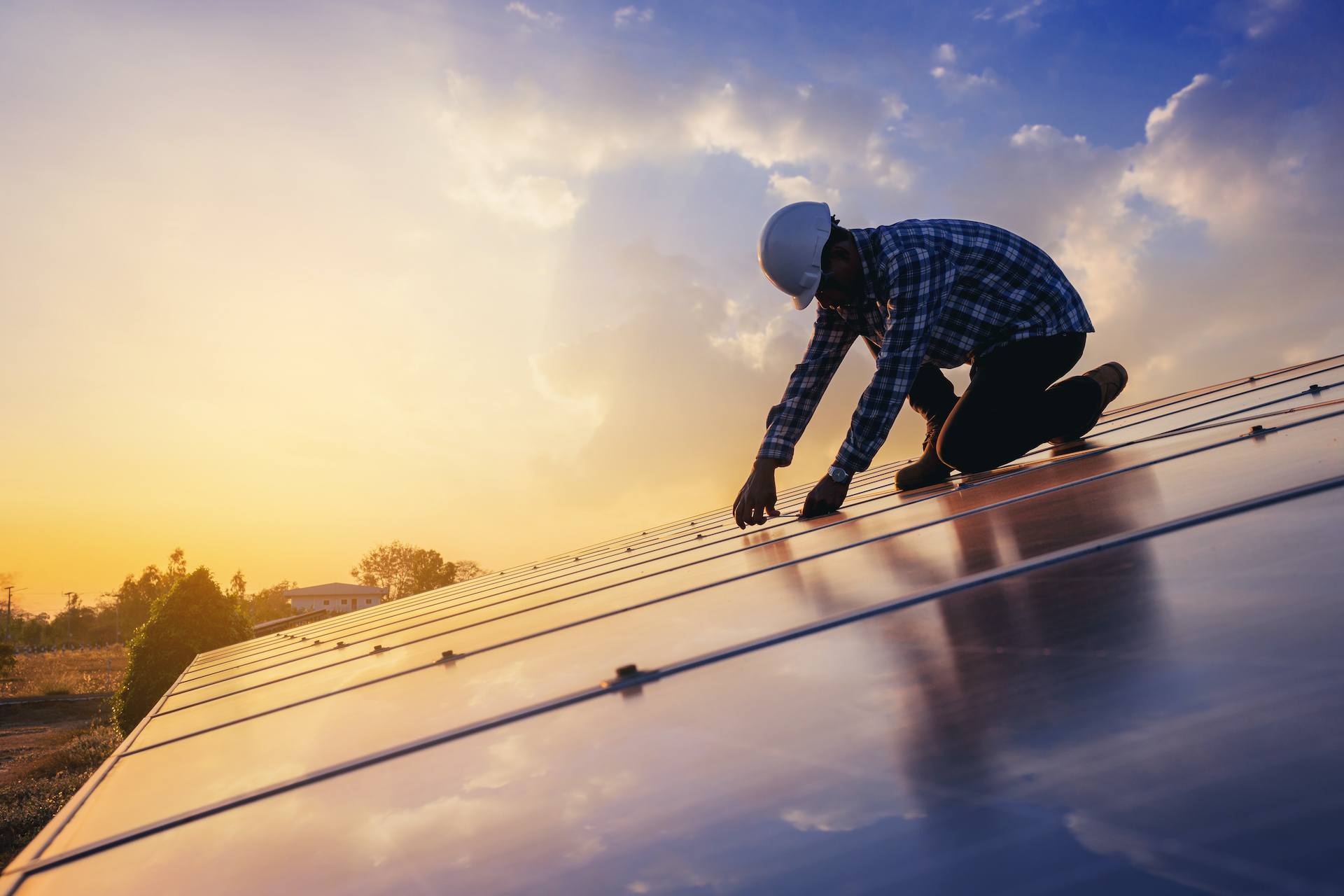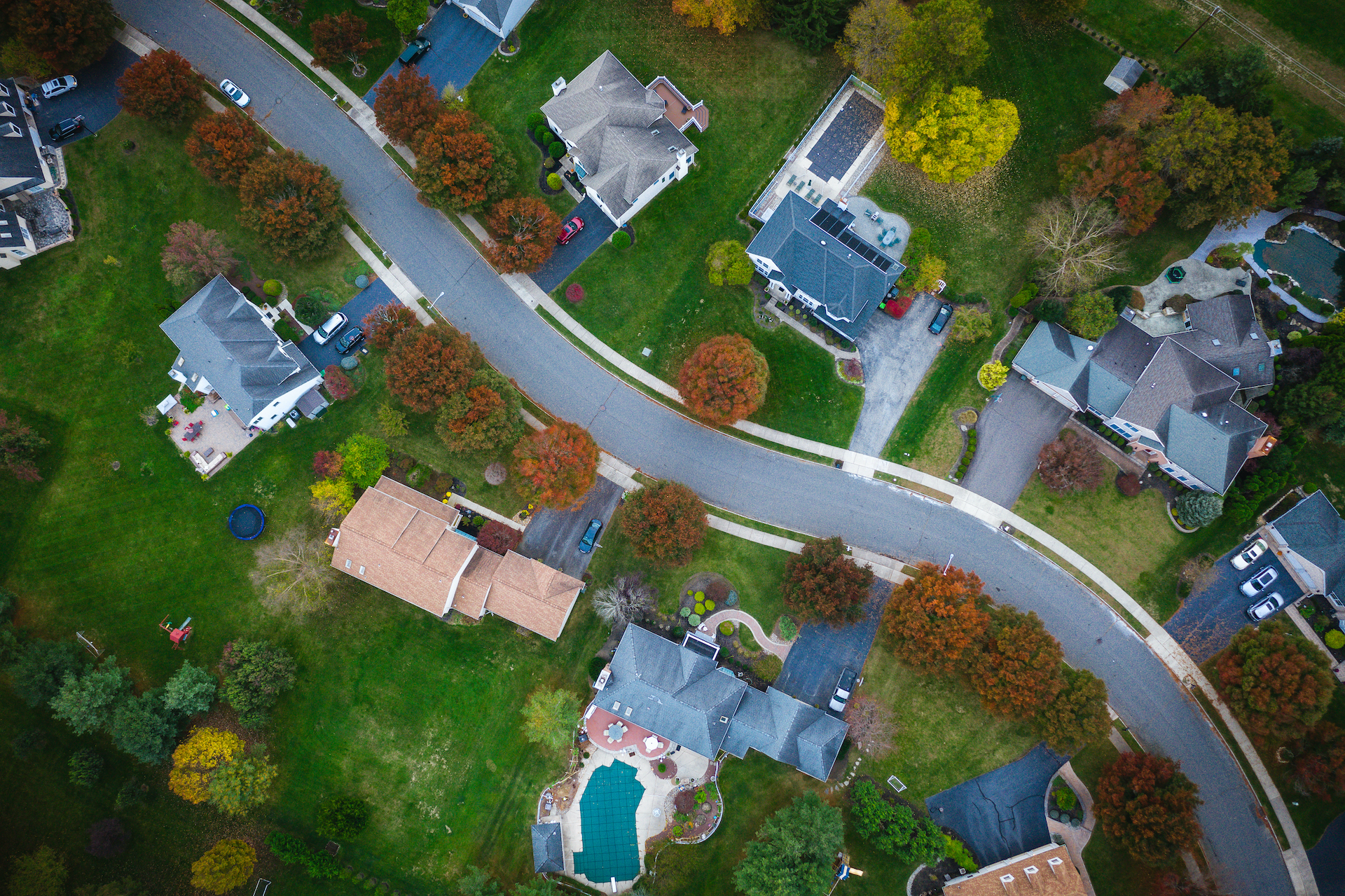How do solar panels for your home work?
At the most basic level, solar panels work by absorbing sunlight and converting it into electricity. However, the real work is done by solar cells, which convert the photons in sunlight to electrons. When sunlight is absorbed by a solar cell, the energy in that sunlight is transferred to electrons in the solar cell, giving them enough energy to free themselves from the solar cell material. A built-in electrical field pulls the electrons in one direction, causing them to flow and creating a current. From there, the electrons are collected by small wires on solar cells, then routed through internal wiring of the solar panel and finally exit through wires on the back of the solar panel.
The electrons continue their journey through the wiring of the solar panel system until they reach an inverter where the electricity from the solar panels is converted to make it identical to the electricity that your power company supplies. The inverter is connected to your electrical panel so the electricity can be routed to where it is needed in order to operate lights, appliances, or other electrical loads in your home. When a solar panel system is “grid-tied” (which most are), any excess energy produced by your solar panels flows back through a meter into the grid. Your meter will measure how much energy you’ve consumed from the utility as well as how much you’ve provided back to the utility.
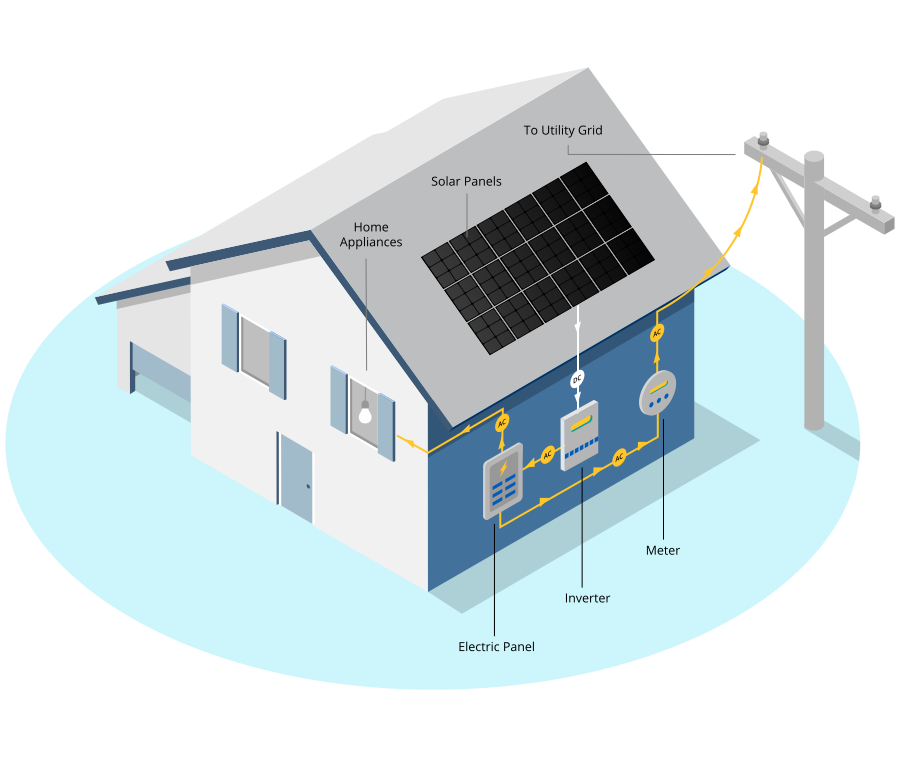
How do solar panels for your home work?
At the most basic level, solar panels work by absorbing sunlight and converting it into electricity. However, the real work is done by solar cells, which convert the photons in sunlight to electrons. When sunlight is absorbed by a solar cell, the energy in that sunlight is transferred to electrons in the solar cell, giving them enough energy to free themselves from the solar cell material. A built-in electrical field pulls the electrons in one direction, causing them to flow and creating a current. From there, the electrons are collected by small wires on solar cells, then routed through internal wiring of the solar panel and finally exit through wires on the back of the solar panel.
The electrons continue their journey through the wiring of the solar panel system until they reach an inverter where the electricity from the solar panels is converted to make it identical to the electricity that your power company supplies. The inverter is connected to your electrical panel so the electricity can be routed to where it is needed in order to operate lights, appliances, or other electrical loads in your home. When a solar panel system is “grid-tied” (which most are), any excess energy produced by your solar panels flows back through a meter into the grid. Your meter will measure how much energy you’ve consumed from the utility as well as how much you’ve provided back to the utility.

Will my solar panels work on a cloudy day?
Cloudy days mean less sunlight which a solar panel can use to generate electricity. So your solar panels will work, but they will produce a lower amount of energy. For example, on a cloudy day, if your solar panels receive half the sunlight that they do on a sunny day, they will produce half the energy they would have on a sunny day.
Cloudy days can also be accompanied by rain or snow. Periodic rain is actually good for your solar panels since it washes off accumulated dust. On the other hand, snow can temporarily block enough sunlight that your solar panels won’t work for a bit. The good news is that snow doesn’t last as long on a solar panel as a traditional roof. A little sunlight will still get through the snow and warm the solar panel, melting the snow.
In any weather situation, the energy generated by solar panels is directly proportional to the amount of sun they receive.
This is why you’ll always want the solar panels to be located where they will receive the most sunlight. Your local weather patterns will influence how much energy a home solar system can generate, but what’s more important is where solar panels are placed on your roof or property. Careful evaluation of shading from nearby trees and other structures is critical to having a good system design and maximizing the return on a home solar investment.
Will my solar panels work on a cloudy day?
Cloudy days mean less sunlight which a solar panel can use to generate electricity. So your solar panels will work, but they will produce a lower amount of energy. For example, on a cloudy day, if your solar panels receive half the sunlight that they do on a sunny day, they will produce half the energy they would have on a sunny day.
Cloudy days can also be accompanied by rain or snow. Periodic rain is actually good for your solar panels since it washes off accumulated dust. On the other hand, snow can temporarily block enough sunlight that your solar panels won’t work for a bit. The good news is that snow doesn’t last as long on a solar panel as a traditional roof. A little sunlight will still get through the snow and warm the solar panel, melting the snow.
In any weather situation, the energy generated by solar panels is directly proportional to the amount of sun they receive.
This is why you’ll always want the solar panels to be located where they will receive the most sunlight. Your local weather patterns will influence how much energy a home solar system can generate, but what’s more important is where solar panels are placed on your roof or property. Careful evaluation of shading from nearby trees and other structures is critical to having a good system design and maximizing the return on a home solar investment.
Will my home solar system work if my power goes out?
Generally no, your home solar system is designed to monitor the presence of the grid and shut down if it does not detect the grid. This is a safety measure for the utility workers who are working to restore grid power. Here’s why: If your system was still producing electricity and some of that electricity was being exported into the grid while utility workers were fixing power lines or other equipment, they could be shocked.
In order for your home solar system to operate when the grid is down, you’ll need to consider a system which includes home batteries. The primary function of home batteries is to store excess energy generated by your home solar system for use when your home solar isn’t producing as much as you are consuming or the grid is down. Home battery systems also provide two features which are critical in enabling a home solar system to function when the grid is down.
First, a home battery system will include a transfer switch to disconnect your home’s electrical system from the grid if the power goes out (same as if you had a generator). Second, they provide a power source for your home solar system. This power source provides the “grid” that your home solar system needs to operate.
Learn more about home batteries here.
Will my home solar system work if my power goes out?
Generally no, your home solar system is designed to monitor the presence of the grid and shut down if it does not detect the grid. This is a safety measure for the utility workers who are working to restore grid power. Here’s why: If your system was still producing electricity and some of that electricity was being exported into the grid while utility workers were fixing power lines or other equipment, they could be shocked.
In order for your home solar system to operate when the grid is down, you’ll need to consider a system which includes home batteries. The primary function of home batteries is to store excess energy generated by your home solar system for use when your home solar isn’t producing as much as you are consuming or the grid is down. Home battery systems also provide two features which are critical in enabling a home solar system to function when the grid is down.
First, a home battery system will include a transfer switch to disconnect your home’s electrical system from the grid if the power goes out (same as if you had a generator). Second, they provide a power source for your home solar system. This power source provides the “grid” that your home solar system needs to operate.
Learn more about home batteries here.
Can I sell my excess solar energy to the utility?
Generally, yes. In most cases, your solar panel system is “grid-tied,” meaning that it is connected to your utility. Suppose your home solar system is producing more electricity than you are currently using in your home. In that case, the excess electricity flows back through your electrical panel and into the utility grid, where others can use it. In this scenario, you are selling the excess electricity produced by your solar panel system back to your utility. Utility policies regarding how you’re compensated for extra solar energy which you export back into their grid can vary widely.
Many utilities have net energy metering (NEM) policies which require that the power company compensate homeowners at the full retail rate (the price that you pay for electricity from the utility) for solar energy exported back into the grid. This means that, for any given month, the net energy you export is subtracted from the net energy you import. If more power is exported than imported, a credit is generated. That credit can be carried forward and used in subsequent months where you consume more than you produce. However, most net energy metering policies also specify how long credits can be carried forward. At the end of an annual billing cycle, some utility companies may pay you for accumulated credits, but in some cases, those credits are forfeited.
If you lose credits at the end of your billing cycle, you’re basically giving that energy to the utility provider for free. You’ll want to understand your power company’s net metering and other home solar policies. But you’ll also want to make sure your home solar system is properly designed so that the energy produced by the system is matched to your expected energy consumption. All too often, solar contractors will attempt to sell the largest system possible to increase their revenue and profit.
Can I sell my excess solar energy to the utility?
Generally, yes. In most cases, your solar panel system is “grid-tied,” meaning that it is connected to your utility. Suppose your home solar system is producing more electricity than you are currently using in your home. In that case, the excess electricity flows back through your electrical panel and into the utility grid, where others can use it. In this scenario, you are selling the excess electricity produced by your solar panel system back to your utility. Utility policies regarding how you’re compensated for extra solar energy which you export back into their grid can vary widely.
Many utilities have net energy metering (NEM) policies which require that the power company compensate homeowners at the full retail rate (the price that you pay for electricity from the utility) for solar energy exported back into the grid. This means that, for any given month, the net energy you export is subtracted from the net energy you import. If more power is exported than imported, a credit is generated. That credit can be carried forward and used in subsequent months where you consume more than you produce. However, most net energy metering policies also specify how long credits can be carried forward. At the end of an annual billing cycle, some utility companies may pay you for accumulated credits, but in some cases, those credits are forfeited.
If you lose credits at the end of your billing cycle, you’re basically giving that energy to the utility provider for free. You’ll want to understand your power company’s net metering and other home solar policies. But you’ll also want to make sure your home solar system is properly designed so that the energy produced by the system is matched to your expected energy consumption. All too often, solar contractors will attempt to sell the largest system possible to increase their revenue and profit.
We work for homeowners to ensure that they are getting a home solar system designed for their best interests. We factor in your local weather patterns, utility policies and energy consumption habits to ensure that you’re only paying for the solar that you want and need.
Learn more about our home solar process here or get started with a free Solar Assessment.
We work for homeowners to ensure that they are getting a home solar system designed for their best interests. We factor in your local weather patterns, utility policies and energy consumption habits to ensure that you’re only paying for the solar that you want and need.
Learn more about our home solar process here or get started with a free Solar Assessment.
Have a question about how home solar works or anything else? Send us a message and we’ll answer ASAP.
Have a question about how home solar works or anything else? Send us a message and we’ll answer ASAP.
Learn about solar
Find honest answers to some of the most commonly asked questions on home solar and clean energy.



